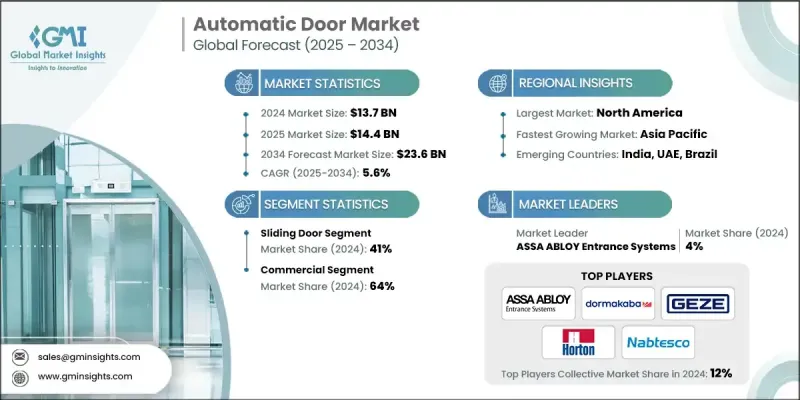
세계의 자동문 시장 규모는 2024년에 137억 달러로 평가되었고, CAGR은 5.6%를 나타낼 것으로 예측되며 2034년에 236억 달러에 이를 전망입니다.

COVID-19 팬데믹 이후 위생 및 공중 보건에 대한 인식이 높아지면서 비접촉 기술로의 전환이 크게 가속화되었습니다. 자동문은 병원, 공항, 소매점, 사무실 건물과 같은 고밀도 환경에서 물리적 접촉 지점을 최소화하는 핵심 솔루션으로 자리 잡았습니다.
| 시장 범위 | |
|---|---|
| 시작 연도 | 2024년 |
| 예측 연도 | 2025-2034년 |
| 시장 규모 | 137억 달러 |
| 예측 금액 | 236억 달러 |
| CAGR | 5.6% |
2024년 슬라이딩 도어 부문은 교통량이 많은 지역에서의 효율성과 공간 활용 극대화 능력으로 상당한 점유율을 차지했습니다. 이러한 도어는 지속적인 흐름과 접근 용이성이 필수적인 공항, 병원, 소매 체인점과 같은 상업 환경에서 선호됩니다. 슬라이딩 도어는 세련되고 현대적인 외관을 제공하며 원활한 작동을 위해 동작 센서가 장착되는 경우가 많습니다. 저마찰 메커니즘과 최소한의 설치 공간으로 인해 신축 건물과 리모델링 모두에 실용적인 선택입니다. 건물 설계가 개방형 공간과 접근성을 지속적으로 강조함에 따라 자동 슬라이딩 도어에 대한 수요는 여전히 강세를 보이며 시장 성장에 꾸준히 기여하고 있습니다.
상업 부문은 쇼핑몰, 오피스 빌딩, 호텔 및 레스토랑, 의료 시설 등 다양한 공간에 널리 도입되며 2024년 상당한 매출을 창출했습니다. 이러한 공간들은 안전성과 미관을 저해하지 않으면서도 지속적인 유동 인구를 처리할 수 있는 신뢰할 수 있고 사용자 친화적인 출입 시스템을 필요로 합니다. 상업용 자동문은 사용자 경험을 향상시킬 뿐만 아니라 공기 흐름과 온도 안정성을 제어하여 에너지 효율성을 지원합니다. 편의성과 위생에 대한 소비자 기대가 지속적으로 높아짐에 따라 기업들은 운영 효율성과 고객 만족도를 높이기 위해 자동 출입 솔루션을 우선적으로 도입하고 있습니다.
북미의 자동문 시장은 강력한 인프라, 높은 건설 기준, 접근성에 대한 규제적 강조에 힘입어 2024년 견고한 점유율을 유지했습니다. 미국은 팬데믹 이후 의료, 소매, 공공 부문 건물 전반에 걸쳐 터치리스 출입 시스템 도입이 증가했습니다. 에너지 효율적이고 스마트한 건물에 대한 관심이 높아짐에 따라 자동문은 기능성과 미적 요소를 겸비한 요소로 현대 건축에 통합되고 있습니다.
자동문 시장의 주요 기업은 Ultra Safe Security Doors, Dormakaba Group, GEZE GmbH, Record USA, Wilcox Door Service Inc., TORMAX USA Inc., Zhejiang Seacon Door Technology Co.Ltd., Royal Boon Edam International BV, Panasonic Corporation, Stanley Access Technologies( Inc., Entrematic, ASSA ABLOY Entrance Systems, Nabtesco Corporation, Horton Automatics.
자동문 업계 기업들은 시장 입지를 강화하기 위해 여러 목표 지향적 전략을 전개하고 있습니다. 제품 혁신은 여전히 핵심으로, IoT 기능 통합, 첨단 동작 센서, 에너지 효율 부품에 중점을 두고 있습니다. 또한 건설 및 스마트 빌딩 기술 공급업체와의 전략적 제휴를 통해 자동문을 광범위한 인프라 프로젝트에 통합하기 위한 투자를 진행 중입니다. 더불어 고객 충성도 구축과 지속적 수익 확보를 위해 애프터서비스, 유지보수 계약, 맞춤형 옵션도 확대되고 있습니다. 인수합병 및 유통 계약을 통한 지역적 확장은 신규 시장 진출을 돕고, 지역별 안전 및 접근성 기준 준수는 경쟁 우위를 강화합니다.
The Global Automatic Door Market was valued at USD 13.7 billion in 2024 and is estimated to grow at a CAGR of 5.6% to reach USD 23.6 billion by 2034.

The heightened awareness of hygiene and public health, after the COVID-19 pandemic, has significantly accelerated the shift toward contactless technologies. Automatic doors have become a critical solution in minimizing physical touchpoints, especially in high-traffic environments such as hospitals, airports, retail stores, and office buildings.
| Market Scope | |
|---|---|
| Start Year | 2024 |
| Forecast Year | 2025-2034 |
| Start Value | $13.7 Billion |
| Forecast Value | $23.6 Billion |
| CAGR | 5.6% |
The sliding door segment held a significant share in 2024, driven by its efficiency in high-traffic areas and ability to maximize space. These doors are favored in commercial environments such as airports, hospitals, and retail chains where continuous flow and ease of access are essential. Sliding doors offer a sleek, modern look and are often equipped with motion sensors for seamless operation. Their low-friction mechanism and minimal footprint make them a practical choice for both new constructions and retrofits. As building designs continue to emphasize open spaces and accessibility, demand for sliding automatic doors remains strong, contributing steadily to market growth.
The commercial segment generated sizeable revenues in 2024, owing to the widespread adoption across shopping malls, office buildings, hospitality venues, and healthcare facilities. These spaces require reliable, user-friendly entry systems that can handle constant foot traffic without compromising on safety or aesthetics. Automatic doors in commercial applications not only improve user experience but also support energy efficiency by controlling airflow and temperature stability. As consumer expectations for convenience and hygiene continue to rise, businesses are prioritizing automated entry solutions to enhance operational efficiency and customer satisfaction.
North America automatic door market held a robust share in 2024, backed by strong infrastructure, high construction standards, and regulatory emphasis on accessibility. The United States has witnessed increased adoption of touchless entry systems across healthcare, retail, and public sector buildings in the post-pandemic era. With a growing focus on energy-efficient and smart buildings, automatic doors are being integrated into modern construction as a functional and aesthetic element.
Major players in the automatic door market are Ultra Safe Security Doors, Dormakaba Group, GEZE GmbH, Record USA, Wilcox Door Service Inc., TORMAX USA Inc., Zhejiang Seacon Door Technology Co., Ltd., Royal Boon Edam International B.V., Panasonic Corporation, Stanley Access Technologies (a part of Dormakaba), Vortex Industries, Inc., Entrematic, ASSA ABLOY Entrance Systems, Nabtesco Corporation, and Horton Automatics.
To strengthen their market position, companies in the automatic door industry are deploying several targeted strategies. Product innovation remains central, with a focus on integrating IoT capabilities, advanced motion sensors, and energy-efficient components. Firms are also investing in strategic partnerships with construction and smart building technology providers to embed automatic doors into broader infrastructure projects. In addition, after-sales services, maintenance contracts, and customization options are being expanded to build customer loyalty and ensure recurring revenue. Geographic expansion through mergers, acquisitions, and distribution agreements helps brands access new markets, while adherence to regional safety and accessibility standards strengthens their competitive edge.